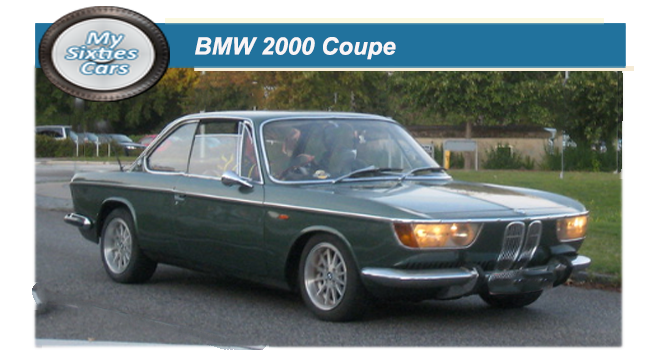 The BMW New Class coupé range, which comprised the BMW 2000 C and BMW 2000 CS, was a coupé body style built by Karmann for BMW from the summer of 1965 to 1969.
The BMW New Class coupé range, which comprised the BMW 2000 C and BMW 2000 CS, was a coupé body style built by Karmann for BMW from the summer of 1965 to 1969.
The New Class coupé was developed from the New Class sedans to showcase the 2.0 L version of the engine used in the sedans.
The new displacement of 1990 cc (121 cu in) was achieved with the 80 millimetres (3.1 in) stroke of the 1.8 L version combined with 89 millimetres.
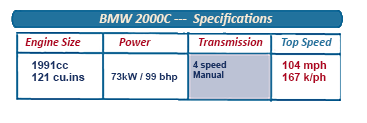 Production of the 2000 Coupes was outsourced to the Osnabruck based Karmann coachbuilders, at that time the largest independent motor vehicle manufacturing company in West Germany whose particular expertise was in producing coupes.
Production of the 2000 Coupes was outsourced to the Osnabruck based Karmann coachbuilders, at that time the largest independent motor vehicle manufacturing company in West Germany whose particular expertise was in producing coupes.
The new “stand-alone” coupe was available fitted with either with a single-carburettor engine ( the 2000 C) or with a twin-carburettor engine (the 2000CS) delivering 120 hp.
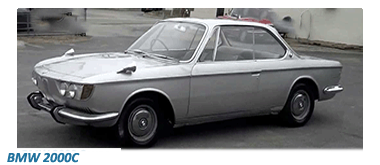 The BMW 2000C was capable of delivering 100 bhp while the 2000CS could generate 120 bhp.
The BMW 2000C was capable of delivering 100 bhp while the 2000CS could generate 120 bhp.
Both versions came with a four-speed manual transmission as standard, although those who preferred an automatic gearbox could specify a ZF three-speed automatic transmission as an option, only in the 2000C version,
![]()
In 1965, BMW ended production of their Bertone-bodied 3200 CS coupé, the last of their line of V8 powered luxury cars from the 1950s. BMW decided to continue with a coach-built coupé. The 2000C was based on a pillarless coupe body designed by Wilhelm Hofmeister, the head of design at BMW from the mid-Fifties till the end of the Sixties.
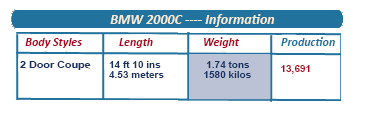 Though graceful enough in profile, some considered the 2000 coupe's front end a bit odd, though it was similar to the larger Bertone-styled 3200CS from the windshield back. That similarity would continue on many subsequent coupes.
Though graceful enough in profile, some considered the 2000 coupe's front end a bit odd, though it was similar to the larger Bertone-styled 3200CS from the windshield back. That similarity would continue on many subsequent coupes.
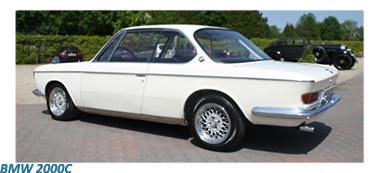 The unique front end was dominated by a tall, narrow version of the usual "kidney' grille, plus a series of vertical slots along the top of the bumpers.
Wraparound headlamp units contained rectangular headlamps and round secondary lamps all in one unit, which wrapped around as turn signals.
No side grilles were installed, with the vehicle's headlamps standing just below the trim strips that ran around the whole car.
The unique front end was dominated by a tall, narrow version of the usual "kidney' grille, plus a series of vertical slots along the top of the bumpers.
Wraparound headlamp units contained rectangular headlamps and round secondary lamps all in one unit, which wrapped around as turn signals.
No side grilles were installed, with the vehicle's headlamps standing just below the trim strips that ran around the whole car.
![]()
Rear quarter windows came to a point at the rear, looking somewhat pentagon-shaped, with a round BMW emblem to the rear of the window near its base.
A circular BMW logo was placed. just ahead of the hood.
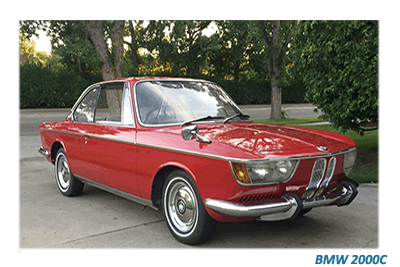 Of the 2000 coupés built between 1965 and the end of production in mid-1969 9,999 were twin carburettor 2000 CS coupés, 3,249 were single carburettor 2000 C coupés with automatic transmission, and 443 were 2000 C coupés with manual transmission.
Of the 2000 coupés built between 1965 and the end of production in mid-1969 9,999 were twin carburettor 2000 CS coupés, 3,249 were single carburettor 2000 C coupés with automatic transmission, and 443 were 2000 C coupés with manual transmission.
The commercial success pf the 2000C and 2000CS “New Class “ coupes' sparked off the release of the more powerful 6-cylinder engined, larger and and longer E9 coupés.






